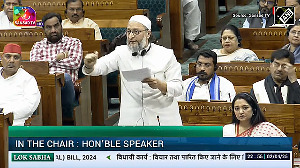March 31 is round the corner. So you have less than two months to do your tax planning. Therefore, it is vital to know the general tax benefits that are on offer so that you can choose such amongst them that are most suitable to your situation.
First let's take a quick glance at the income-tax rates applicable to an individual and then go on to discuss the tax benefits.
|
Table 1: Income Tax Rates for Individuals & HUFs | ||
|
Net taxable income slab (in Rs) |
Tax at minimum |
Marginal rate (%) |
|
Under 50,000 |
Nil |
Nil |
|
50,000-60,000 |
Nil |
10 |
|
60,000-1,50,000 |
1,000 |
20 |
|
Over 1,50,000 |
19,000 |
30 |
Surcharge @10 per cent on tax computed after deductions of rebates is levied on individuals, HUFs, AOPs and BOPs only if the net total income is over Rs 8.50 lakh.
In such cases the tax payable along with the surcharge, is limited to the excess over Rs 8.50 lakh. Surcharge is payable by both Residents and NRIs.
Section 88
Contributions by an individual or HUF to some specified schemes (such as specific MF schemes, PPF, life insurance, NSC etc.) qualify for a tax rebate. The rates of rebate are :
30 per cent for employees whose salary i) does not exceed Rs 1 lakh before deductions u/s 16 (standard deduction and professional tax) and ii) is not less than 90 per cent of his gross total income (before deduction under Chapter-VIA) from all sources.
20 per cent for those with gross total income of Rs 1.5 lakh or less.
15 per cent for those whose gross total income is more than Rs 1.5 lakh but does not exceed Rs 5 lakh and
Nil for those with more than Rs 5 lakh gross total income.
The aggregate contribution to all these schemes qualifying for rebate is subject to a ceiling of Rs 70,000.
A higher qualifying limit of Rs 1 lakh is applicable to infrastructure-related instruments such as the tax-saving bonds of ICICI/IDBI with a lock-in of three years.
The other thing to note here is that the limit mentioned is just for availing of the tax benefit. However, one may invest more if one so desires.
Rebate for senior citizens : Section 88B
Residents who are over 65 years of age at the end of the financial year are called senior citizens. All such persons are entitled to claim tax rebate of Rs 20,000.
Rebate for non-senior women : Section 88C
Any Resident woman, below the age of 65 years is eligible to claim 100 per cent tax rebate or Rs 5,000, whichever is lower.
Once she becomes a senior citizen, she loses this concession but starts enjoying the higher rebate for senior citizens discussed above.
|
Table 2: | |
|
Gross Total Income |
240,000 |
|
Less : |
|
|
Deduction u/s 80L |
12,000 |
|
Deduction u/s 80CCA |
10,000 |
|
Deduction u/s 80D |
15,000 |
|
Net income |
203,000 |
|
Tax thereon : |
35,000 |
|
Tax rebate u/s 88 |
15,000 |
|
Tax Rebate u/s 88B |
20,000 |
|
Net tax payable |
NIL |
Pension plans : Section 80CCC
LIC and the current crop of private insurers administer pension plans with various payout options which can be suited to one's needs.
Here the idea is to fund one's own pension during your productive years by contributing during the working life. The premiums paid are deductible u/s 80CCC up to Rs 10,000 per year. This is an income rebate and not a tax rebate.
In other words, the amount paid under the plan is directly reduced from one's income chargeable to tax and not from the final tax payable like it is done u/s 88.
Also, the entire pension received is taxed in the hands of the recipient as income of that year.
Mediclaim : Section 80D
Deduction up to Rs 10,000 is allowed in respect of medical insurance premiums paid by cheque by an individual. The premiums may be paid on the health of the investor himself, the spouse, dependent children or parents.
The same benefit is also available to an HUF for its members. Mediclaim is available with a ceiling on target amount up to Rs 3 lakh to all individuals up to 70 years of age.
For a senior citizen, a higher deduction of Rs 15,000 is available.
It may be noted that if one takes advantage of the above mentioned tax benefits and throws in Section 80L (interest up to Rs 12,000 tax exempt) then an income up to Rs 240,000 instead of the basic threshold of Rs 50,000 can be made completely tax-free.
How? Consider table 2. Section 88 rate of rebate is assumed to be 15 per cent. The calculations are in the case of senior citizens. For non-senior citizens, depending upon the gender, the corresponding figures would differ.
Deductions available in respect of house property
For loans taken on or after April 1, 1999 for acquiring or constructing house property, interest up to Rs 150,000 is deductible.
The acquisition or construction should be completed within 3 years from the end of the year in which the capital was borrowed. There is no stipulation regarding the date of commencement of construction.
Also, payments towards cost of construction or acquisition of a residential house property, qualify for rebate u/s 88 with a ceiling of Rs 20,000 provided such payments are part payments of loans from approved sources.
If the house is sold before 5 years from the end of the FY in which its possession was taken, aggregate rebate claimed shall be added to the tax liability on normal income of the taxpayer for the year during which the house is sold. The same tenet is not applicable to the deduction of interest.
Capital gains
U/s 54ED, exemption on LTCG is available for equity shares sold, forming part of the BSE 500 index as on March 1, 2003 purchased from the secondary market from March 1, 2003 to February 29, 2004, or for IPOs made on or between March 1, 2003 and February 29, 2004.
These shares have to be held for at least one year and have to be sold in the secondary market. The CBDT has clarified that even shares forming part of a public offer for sale by existing shareholders would be eligible if the offer is made within the specified dates.
On the other hand, u/s 54EC, long-term capital gains (LTCG), after indexation, would be tax exempt if the gains are invested in bonds of NABARD, NHAI, REC, NHB and SIDBI. These bonds carry a lock-in of 3 years.
Also u/s 54 if a house is sold and the LTCG are invested in another house property, there is exemption available.
A similar exemption is available u/s 54F for long-term assets other than house property but here the net consideration has to be invested.






 © 2025
© 2025